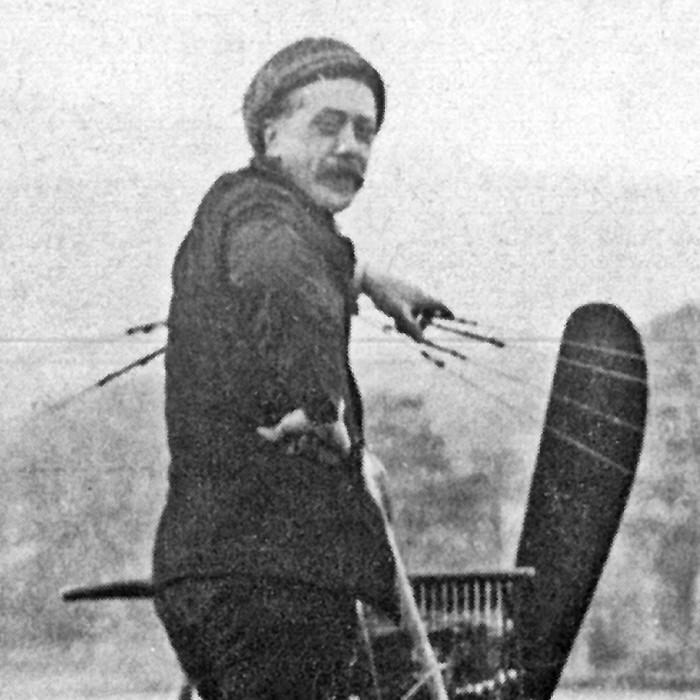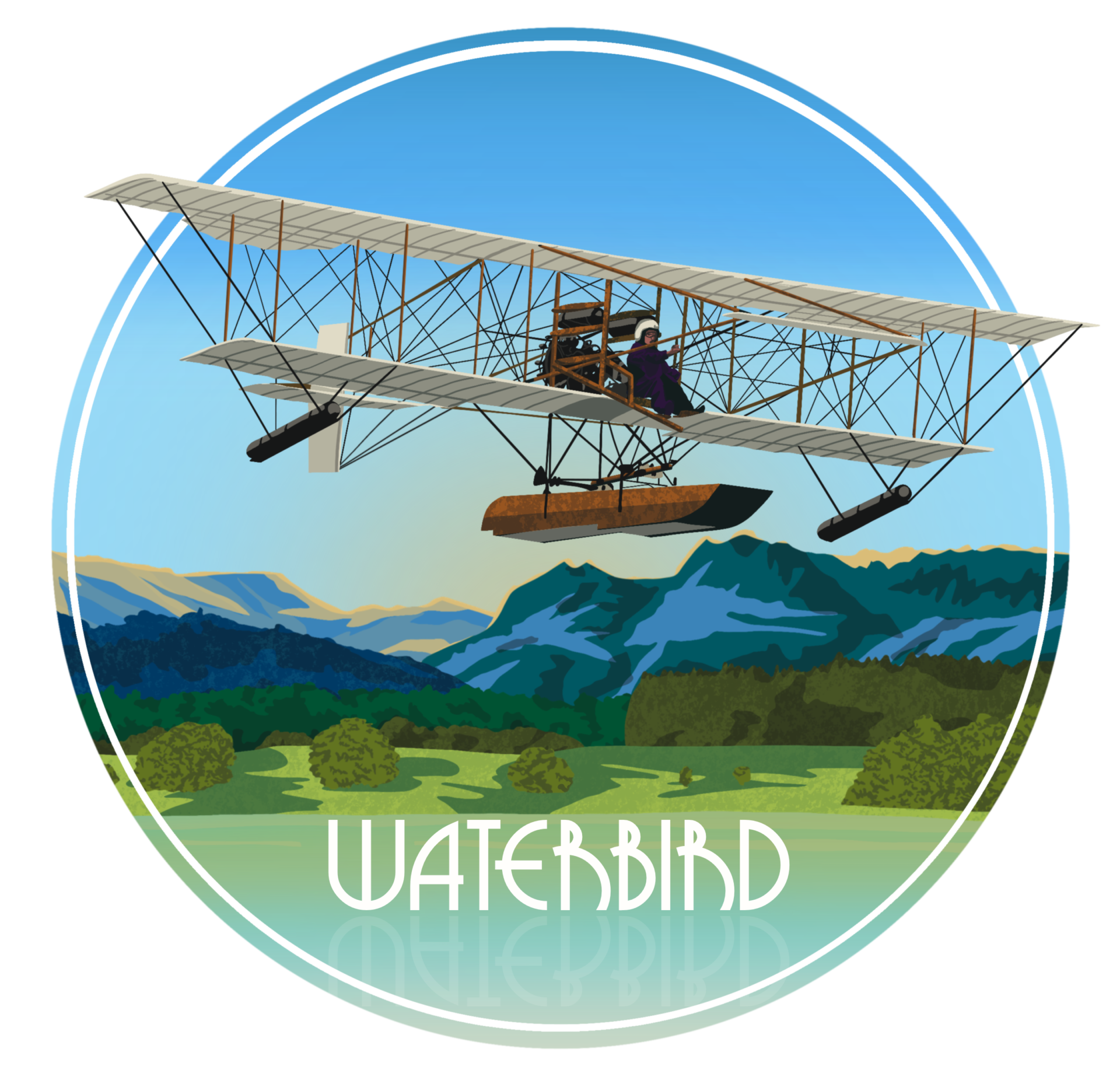Major Oscar Theodor Gnosspelius, ACGI MIAeE (Hons.) FRAeS (1878 – 1953)

Oscar Gnosspelius was a pioneer aeronautical engineer, the only person at Windermere to design and fly his own hydro-aeroplane. In July 1910, he was the first person in the world to design and test floats with a ‘step’.
Gnosspelius was born at Liverpool and had a Swedish father. By profession he was a civil engineer, and had worked in London, Sweden, South America and Africa. He passed the Associate of the City and Guilds Institute at the Central Technical College, London in 1898. For 3 years he was a pupil with Freeman, Fox & Partners, under Sir Douglas Fox where he worked on the Northern and City branch of the London Underground. From 1909 he lived at Silverholme, Graythwaite, his mother Amelia’s home on the south-west shore of the lake.
This photograph of the replica Waterbird has Silverholme in the background.
Hydro-aeroplane Designs
Having attended the Blackpool Aviation Meeting in October 1909, Gnosspelius began the task of designing an aeroplane which was capable of flying from water. His motive was that it would be more sensible to use freely available water than expensive land. He was a ‘skilled fitter and turner, who had served his time at a boat builder’s yard [Crossfield’s] at Arnside, and no doubt did much of the actual construction himself’. – Britain’s Seaplane Pioneers by M H Goodall, Air Pictorial December 1987.
Gnosspelius was collaborating with Edward Wakefield from an early stage and in early August 1910 his hydro-aeroplane was transferred to Wakefield’s hangar at Hill of Oaks.
On 8 August 1910, aviation pioneer Claude Graham-White, whilst on a visit to a friend, inspected the hydro-aeroplane of Gnosspelius and ‘commended the construction of it, while suggesting a few modifications’. – The Westmorland Gazette, 13 August 1910.
On 26 October 1910, Wakefield and Gnosspelius visited Henri Fabre at Paris, where his Hydravion was being exhibited. Fabre had made the world’s first flight from water on 28 March that year. Gnosspelius made a plan and detailed notes.
In July 1910, floats with a ‘step’ were constructed by Borwick & Sons, boat builders of Bowness-on-Windermere, for Gnosspelius from his designs and which he tested at Windermere, just south of Rawlinson Nab – the first floats with a hydroplane step in the world. Gnosspelius started with 2 floats, but at the end of 1910 switched to a single float with 1 step.
The wings were of a Blériot-type. A king post above the fuselage supported bracing and warping wires.
Gnosspelius No. 1 had an open latticework fuselage of rectangular cross-section with 6 bays.
Gnosspelius No. 2 had a triangular section fuselage of 12 bays. The central float was 12 feet by 5 feet. In April 1912, the front fuselage was enclosed by fabric resulting in a great improvement to flying characteristics.
Gnosspelius No. 2 ‘was the first British hydro-aeroplane to employ auxiliary wingtip floats’. – The History of British Aviation 1908-1914 by R D Brett. The design of the wingtip floats was initially streamlined, then higher box type and finally airbag type (Belle Ilse in the background).
The Hydroplane Step
Gertrude Bacon, who flew as a passenger at Windermere in 1912, described the step in her book All About Flying as follows: ‘The lower surface of the float, instead of being all of 1 piece, changes or ‘steps’ abruptly to another level. Some floats have 1 step, some more’.
Wakefield obtained UK Patent No. 27,771 for a stepped float, having applied on 11 December 1911. The application was opposed by The British & Colonial Aeroplane Company Ltd (whose aeroplanes were prefixed Bristol), with a statutory declaration by Gnosspelius.
It was the view of Arthur Edwards & Co Ltd, Wakefield’s Patent Agents, that Bristol had no standing since there was no evidence to show their interest either as manufacturers or under prior patents. Wakefield, a Barrister, represented himself.
At the end of the Hearing, the Judge declared the sealing of a patent and awarded legal costs in Wakefield’s favour, stating that he would give his full decision in a written judgment.
Delivered on 18 March 1913, the decision was that, having conducted considerable experiment successfully, Wakefield had combined features in a novel way.
There does not appear to have been any ill-feeling between Gnosspelius and Wakefield; in The Aeroplane magazine of 25 January 1912, Gnosspelius had been described as ‘designer and engineer to [Wakefield’s] the Lakes Flying Company’.
Flight
Gnosspelius received instruction in February 1911 by Howard Pixton (later Captain) at the Avro Flying School at Brooklands, where he learned to fly straight and level. – The Aero magazine, 8 February 1911.
Gnosspelius No. 1 was not capable of taking off due to the lack of power from a 20 horse power two-cylinder air-cooled Alvaston engine.
On 25 November 1911, Gnosspelius set out from a boathouse of Borwicks at Bowness Bay in Gnosspelius No. 2 powered by a 50 horse power four-cylinder inline water-cooled Clerget 4 V engine. He achieved the first take-off from Windermere. However, within a minute, following a gust of wind, control was lost and a wingtip dug into the water causing the hydro-aeroplane to turn over from back to front. – The Westmorland Gazette, 2 December 1911.
Unaware of Gnosspelius’ accident off Belle Isle, on the morning of 25 November 1911 Herbert Stanley Adams taxied out from Hill of Oaks in Waterbird, commissioned by Wakefield as a landplane from A. V. Roe and Company, took off and alighted. It was the first successful flight off water outside of France and the USA, and the first in the world to use successfully a stepped float. Gnosspelius’ mother wrote a letter to congratulate Wakefield.
The first successful flight was made by Gnosspelius No. 2 on 14 February 1912. ‘The machine thus captures the honour of being the first hydro-monoplane of normal type to fly properly, as well as being the first hydro-monoplane of any type to leave British waters.’ – The Aeroplane magazine, 29 February 1912.
Gnossspelius had met Ronald Kemp whilst at Brooklands, where he later test-flew Waterbird as a landplane on 27 June 1911. Recognising his limited piloting ability, Gnosspelius invited Kemp to carry out test flights at Windermere in April 1912. This photograph, Flight magazine, 27 April 1912, is of Gnosspelius No. 2 during a 12-mile flight by Kemp on 17 April, when he flew to Lakeside, Beech Hill, then back to Lakeside and returned to Hill of Oaks. – The Lancaster Guardian, 20 April 1912.
There are 12 known photographs of Gnosspelius No. 2 taken by Frank Herbert, of which 4 were made into postcards.
Other work
Gnosspelius designed the Gnosspelius-Trotter, the Lakes Monoplane, the wings for Seabird, the float for the Avro 501 and the float for the Bristol Coanda. – Gnosspelius No. 1 and No. 2 were both hydro-monoplanes, whereas Waterbird and Waterhen were hydro-biplanes.
Float Design
In a move away from the design of initial seaplane floats, as first used by himself and Wakefield, Gnosspelius obtained UK Patent No. 10,801 on 12 February 1914 for a V–shaped construction. – Every float made today is stepped and V-shaped.
After Windermere
Gnosspelius joined the Royal Naval Volunteer Reserve on 21 August 1914, as a member of the inspection staff at the Admiralty Air Department and then at the Technical Department where he served until the end of the War, becoming a Lieutenant Commander and later a Major upon formation of the Royal Air Force.
He was engaged by Short Brothers at Rochester in 1919 to take charge of the Experimental Department. Despite leaving Shorts in 1925, he took part on many of their test flights into the 1930s.
On 12 December 1922, he read a paper Experimental Data Without a Wind Channel at a meeting of the Institution of Aeronautical Engineers.
Commodore (later Rear Admiral Sir) Murray Sueter recommended John Lankester Parker, a Windermere instructor, to Oswald Short for the position of a test pilot at Eastchurch. Parker became Chief Test Pilot for Shorts 1918-1945, and in September 1942 test-flew the first Windermere-assembled Sunderland flying boat. Parker took over from Ronald Kemp as Chief Test Pilot, who had flown Waterbird as a landplane at Brooklands in June 1911 and Gnosspelius No. 2 at Windermere in April 1912. Gnosspelius served under Sueter at the Air Department.
‘Whilst employed by Short Brothers he devised an ingenious alternative to the wind-tunnel for making model tests. In this the model was attached to the end of a long pendulum, and the drag and other characteristics of the model were deduced for the changes it produced in the pendulum’s motion.’ Obituary in the Aeroplane magazine, 8 May 1953.
Gnosspelius designed a Gull aeroplane, which was built by Shorts at Rochester and test-flown by Parker on 26 May 1923.
Further to the floats which Gnosspelius had constructed with a step in 1910, on 2 August 1923 UK Patent No. 192,568 was granted to Gnosspelius, Eustace Short, Oswald Short and Arthur Gouge for a similar step in the upper surface of a lifting aerofoil. The novel feature of the entire design of the Gull was a step in the upper wing surface, which improved efficiency.
Gnosspelius accompanied Parker on the delivery to Saint-Raphaël during 9-10 September 1929 of a Calcutta flying boat ordered for the French Government, when navigation was accomplished by using a Bartholomew’s road map.
Short Sunderland flying boat production at Windermere
German bombers attacked Rochester in 1940, achieving a direct hit on the Shorts’ works, so it was decided to urgently disperse part of Sunderland flying boat production. In coming to a decision as to where that factory should be located, there was a significant resource to draw upon of experience at Windermere by Gnosspelius, Kemp and Parker. Gnosspelius was involved on behalf of Shorts in the local negotiations for the factory built at White Cross Bay.
Highlights
On 14 February 1912, Gnosspelius was elected as a member of the Royal Aero Club. He was a member of the Institute of Aeronautical Engineers, which was incorporated into the Royal Aeronautical Society in 1927. He was elected an Associate Fellow of the Royal Aeronautical Society in 1918 and a Fellow in 1940.
In 1920, a dinner to the Pioneers of British Aviation was held at the Connaught Rooms in London. He was one of the guests, as was Gertrude Bacon.
Gnosspelius also had an interest in motor boats, being a first year member of the Windermere Motor Boat Club which was formed on 24 October 1925. He wrote a chapter entitled ‘Motor-boating’ for the book The Lake Counties by his father-in-law W G Collingwood.
Arthur Ransome
Arthur Ransome dedicated his 1936 book Pigeon Post ‘To Oscar Gnosspelius‘, in which the character Squashy Hat was based upon him. The children of his sister-in-law Dora Altounyan were the inspiration for Ransome’s Swallows.
Engagement to Barbara (Ransome proposed to both Dora and Barbara) was announced in Flight magazine of 18 June 1925 and they married on 15 September 1925 at Hawkshead, when Parker was best man, Gnosspelius then resided at his in-laws’ home of Lanehead, Coniston. He is buried alongside his wife at Coniston cemetery. Their niece Mavis “Titty” Altounyan is also buried at the cemetery, as is Donald Campbell.
– ‘Major Gnosspelius is a singularly ready mind, which refuses to admit we are at the end of discovery in the region of the natural laws on which flight is based.’ The Old Flying Days by Major C C Turner.
– ‘Possessed of a great ability as an engineer, he always seemed to be entirely devoid of any trace of personal ambition, except a powerful urge to do himself such things as seemed to him to be worth doing for their own sake and not merely because they would be profitable to him’. Obituary in the Aeroplane magazine, 8 May 1953 by W H Sayers, Technical Editor, who had co-designed the Lakes Monoplane.
